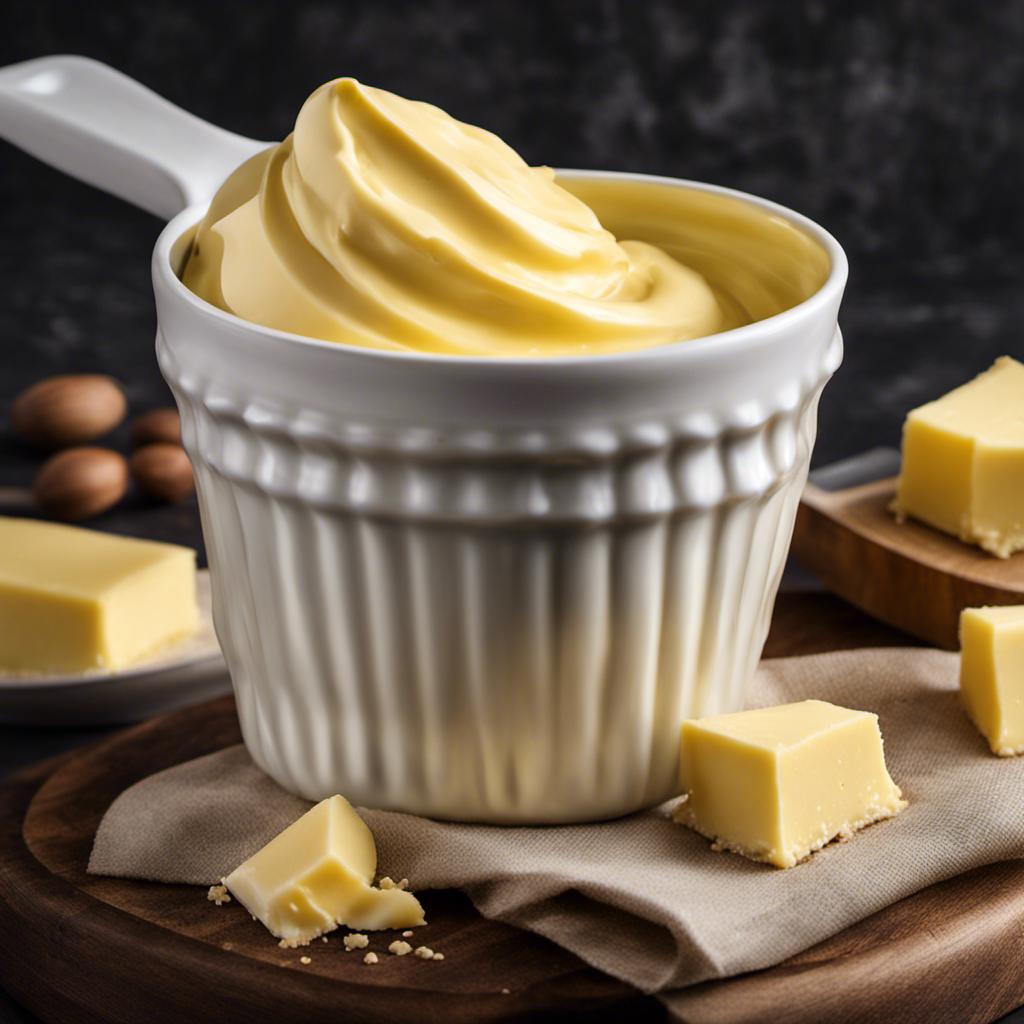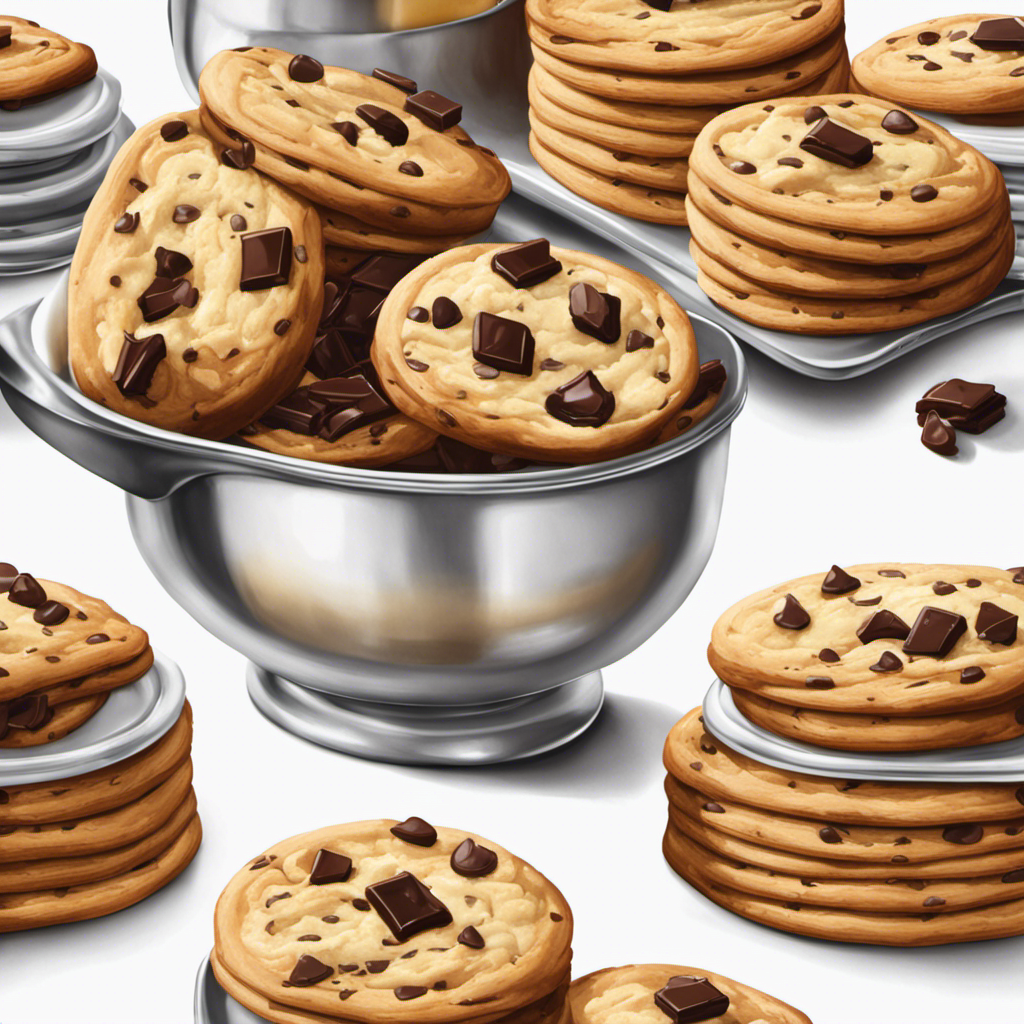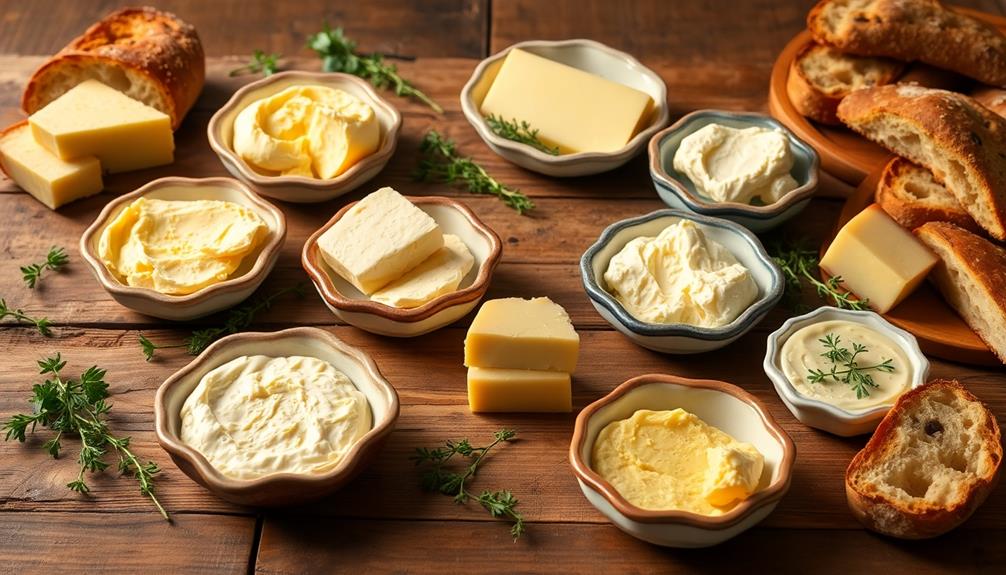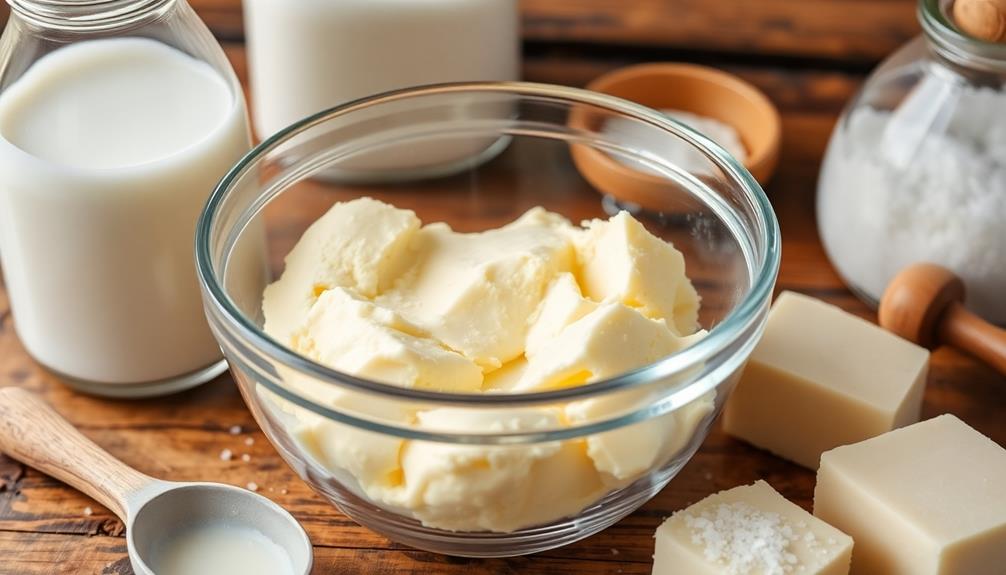You might be wondering – what exactly does 1/3 cup of butter amount to? Allow me to simplify it for you. In this piece, I’ll share a chart for converting butter quantities, detail the steps to accurately measure 1/3 cup of butter, and give you some advice on ensuring precise butter measurements for your culinary endeavors.
Whether you’re baking or cooking up a savory dish, understanding butter measurements is key. So, let’s dive in and demystify the world of butter measurements together.
Key Takeaways
- 1/3 cup of butter is equal to 5 1/3 tablespoons or approximately 2.67 ounces.
- Accurate measurements are key to consistent results in baking.
- Understanding butter measurement conversions allows you to confidently follow any recipe.
- Experimenting with butter substitutes can lead to healthier and delicious twists on recipes.
Butter Conversion Chart
Here’s a butter conversion chart to help you figure out how much 1/3 cup of butter is.
When it comes to baking and cooking, precise measurements are essential. Converting butter to ounces can be confusing, but this chart will make it easier for you.
1/3 cup of butter is equal to 5 1/3 tablespoons or approximately 2.67 ounces.
This conversion is useful when you have a recipe that calls for a specific amount of butter in ounces, and you need to measure it using a standard measuring cup. By knowing the butter measurement equivalents, you can ensure that your recipes turn out just right.
Understanding Butter Measurements
When it comes to baking, understanding butter measurements is crucial for achieving the perfect texture and flavor in your recipes. Butter measurement conversions can be confusing, especially when a recipe calls for butter in different forms such as cups, tablespoons, or grams.
Additionally, knowing how to substitute butter in recipes is important for those with dietary restrictions or preferences.
Lastly, accurate measurements are key to ensuring consistent results in baking, as even a small variation in butter can significantly alter the outcome of your baked goods.
Butter Measurement Conversions
To convert 1/3 cup of butter, you’ll need to multiply it by 5.33 tablespoons. Butter measurement equivalents can be confusing, but understanding the conversions can make your baking and cooking experiences much smoother. Here’s a handy table for common butter measurement conversions:
| Cups (C) | Tablespoons (tbsp) | Grams (g) |
|---|---|---|
| 1/4 | 4 | 57 |
| 1/3 | 5.33 | 76 |
| 1/2 | 8 | 113 |
| 1 | 16 | 227 |
Now that you know how to convert butter measurements, you can confidently follow any recipe. But what if you run out of butter or want a healthier alternative? Don’t worry, in the next section, we’ll explore how to substitute butter in recipes.
Substituting Butter in Recipes
If you want a healthier alternative or run out, you can substitute butter in recipes. Here are three healthier butter options to consider:
-
Avocado: Avocado is a great option for replacing butter in recipes. It has a creamy texture and is packed with healthy monounsaturated fats. Simply mash a ripe avocado and use it as a 1:1 substitute for butter.
-
Coconut oil: Coconut oil is another excellent choice for butter alternatives. It adds a subtle, tropical flavor to your dishes and is rich in medium-chain triglycerides. Use melted coconut oil as a 1:1 replacement for butter in your recipes.
-
Greek yogurt: Greek yogurt is a versatile ingredient that can be used as a substitute for butter in various recipes. It adds moisture and creaminess to your dishes while reducing the fat content. Replace butter with an equal amount of Greek yogurt for a healthier twist.
These butter alternatives not only offer health benefits but also add unique flavors and textures to your favorite recipes. Give them a try and enjoy a healthier, delicious twist on your dishes.
Importance of Accurate Measurements
Remember, accurate measurements are crucial for achieving the desired results in your recipes. When it comes to butter, using the right amount can make a significant difference in the taste and texture of your dishes. To ensure precise measurements, it’s essential to understand different butter measurement techniques. Here’s a handy table to help you convert common measurements:
| Measurement | Equivalent |
|---|---|
| 1 stick | 1/2 cup |
| 1/2 stick | 1/4 cup |
| 1/4 stick | 2 tablespoons |
Butter Equivalents
When it comes to baking and cooking, accurate measurements are key to achieving the desired result.
One common ingredient that often requires conversion is butter. Understanding butter measurement conversions, such as how much is 1/3 cup of butter, can help ensure that your recipes turn out just right.
Additionally, it’s always handy to know substitutes for 1/3 cup of butter in case you run out or prefer a healthier alternative.
Butter Measurement Conversions
There’s no need to stress about how much is 1/3 cup of butter – it’s a common measurement in baking. Butter equivalents and converting butter measurements can be helpful when following a recipe or making substitutions.
Here are three key conversions to keep in mind:
-
1/3 cup of butter is equal to 5 1/3 tablespoons or 76 grams. This measurement is often used in recipes for cakes, cookies, and other baked goods.
-
If you need to substitute 1/3 cup of butter, you can use 1/4 cup plus 2 tablespoons of vegetable oil or coconut oil. This substitution works well in most recipes and maintains the desired texture and flavor.
-
Another option is to use 1/3 cup of unsweetened applesauce as a healthier alternative. This substitution reduces the fat content and adds a subtle sweetness to the dish.
Understanding these conversions and substitutions will ensure your baking endeavors are successful.
Now, let’s explore some substitutes for 1/3 cup butter.
Substitutes for 1/3 Cup Butter
If you’re looking to substitute 1/3 cup of butter in a recipe, you can try using 1/4 cup plus 2 tablespoons of vegetable oil or coconut oil instead. These vegan butter alternatives not only provide a similar texture and flavor to butter but also offer some health benefits.
Vegetable oil, such as canola or olive oil, is a great option as it is low in saturated fats and high in heart-healthy monounsaturated fats. Coconut oil, on the other hand, adds a unique tropical taste to your baked goods and is rich in medium-chain triglycerides, which are believed to have several health benefits.
Both options are suitable for those following a vegan or dairy-free diet and can be used in a variety of recipes, from cookies to cakes. So, the next time you’re baking, consider these healthier alternatives to butter.
Importance of Accurate Measurements
Accurate measurements are crucial for achieving consistent and delicious results in your baking. As a baker, I have learned the importance of precise ingredient ratios and the impact they have on the final outcome of my baked goods. Here are three key reasons why accurate measurements matter:
-
Consistency: By using the correct measurements, you ensure that your recipes turn out the same way every time. This is especially important when it comes to butter, as it affects the texture and flavor of your baked goods.
-
Proper rise: Baking is a science, and precise measurements play a vital role in achieving the desired rise in your cakes, cookies, and pastries. Too much or too little butter can throw off the balance, resulting in flat or dense baked goods.
-
Flavor balance: Butter adds richness and flavor to your baked goods. By measuring it accurately, you can maintain the perfect balance of flavors in your recipes. Too much or too little butter can overpower or underwhelm the taste of your baked goods.
Converting 1/3 Cup Butter to Grams
To convert 1/3 cup of butter to grams, you’ll need to multiply the value by 227. This is because 1 cup of butter weighs approximately 227 grams.
If you want to convert butter to ounces, you can multiply the number of cups by 8, as there are 8 ounces in a cup. Therefore, 1/3 cup of butter is equivalent to about 2.67 ounces.
On the other hand, if you need to convert butter to tablespoons, you can multiply the number of cups by 16, since there are 16 tablespoons in a cup. In this case, 1/3 cup of butter would be approximately equal to 5.33 tablespoons.
How to Measure 1/3 Cup Butter
When it comes to baking, accurate butter measurements are crucial for achieving the perfect texture and flavor.
In this discussion, we will explore different methods to measure 1/3 cup of butter with precision.
Additionally, we will delve into substitutes for 1/3 cup of butter and highlight common mistakes made when measuring this amount.
Accurate Butter Measurements
You can easily measure the amount of butter accurately by using a measuring cup. Here are three techniques to ensure butter measurement accuracy:
-
Softened Butter: To measure softened butter accurately, pack it into a measuring cup until it is level with the top. Use a spatula to smooth out any uneven edges.
-
Cold Butter: For cold butter, cut it into tablespoon-sized portions and pack them tightly into a measuring cup. Scrape off any excess butter to ensure an accurate measurement.
-
Melted Butter: When measuring melted butter, pour it into a liquid measuring cup. Make sure to account for any foam or air bubbles by scraping off the excess until the measurement is accurate.
Substitutes for 1/3 Cup
If you’re in need of a substitute for 1/3 cup, consider using alternative ingredients to achieve similar results.
When it comes to butter substitutes, there are a variety of options available that can provide the same richness and flavor. One popular choice is margarine, which is made from vegetable oils and can be used in equal amounts as butter.
Alternatively, you can try using coconut oil, which adds a subtle tropical taste to your dishes. Another option is avocado, which not only adds a creamy texture but also provides healthy fats. These alternative spreads can be great substitutes for 1/3 cup of butter in your recipes, allowing you to achieve similar results while catering to dietary preferences or restrictions.
Now, let’s move on to some common mistakes made when measuring butter.
Common Mistakes Made
When it comes to measuring butter accurately, there are a few common mistakes that people often make. Here are some tips to help you measure butter correctly:
-
Use butter measurement equivalents: If a recipe calls for a specific amount of butter in cups, but you only have a stick of butter, it’s important to know the conversion. One stick of butter is equal to 1/2 cup or 8 tablespoons.
-
Soften butter properly: Softening butter before measuring it is essential for accurate results. Leave the butter at room temperature for about 30 minutes, or you can place it in the microwave for a few seconds until it becomes soft but not melted.
-
Measure butter accurately: When measuring butter, use a kitchen scale for precise measurements. If you don’t have a scale, use a measuring cup with markings specifically for butter.
Butter Substitutions
To substitute butter, you can use margarine or oil in the same amount. There are several butter alternatives available for those looking for vegan options or wanting to reduce their intake of saturated fats. Margarine is a common substitute and can be used in equal amounts in most recipes. It has a similar texture and taste to butter, making it a versatile choice. Another option is using oil, such as vegetable or coconut oil, which can be used as a 1:1 replacement for butter. However, keep in mind that the flavor and texture of the final dish may be slightly different when using oil instead of butter.
Now, let’s move on to discussing the conversion of butter for baking recipes.
Butter Conversion for Baking Recipes
You’ll need to adjust the amount of butter in your baking recipes if you want to use a different type of fat. Here are some butter measurement equivalents and butter conversion ratios that can help you make the necessary adjustments:
- 1 cup of butter is equal to 2 sticks or 16 tablespoons.
- If a recipe calls for 1/2 cup of butter, you can substitute it with 8 tablespoons or 1 stick.
- To convert tablespoons to grams, simply multiply the number of tablespoons by 14.18. For example, 4 tablespoons of butter would be approximately 56.72 grams.
When making substitutions, it’s important to keep in mind that different fats have different properties, which may affect the texture and taste of your baked goods. Experimenting with different ratios and types of fats can lead to delicious and unique results in your baking.
Converting Butter Measurements for Cooking
Converting butter measurements for cooking can be done by substituting with different fats. When it comes to baking, it’s important to get the measurements right to ensure the perfect outcome.
If a recipe calls for a specific amount of butter, but you don’t have enough or want to use a healthier alternative, there are options. One common substitution is using oil instead of butter. For every 1 cup of butter, you can use 3/4 cup of oil.
Another option is using margarine, which can be substituted in equal amounts for butter. If you prefer a dairy-free option, coconut oil can be used as a 1:1 substitute for butter.
These butter measurement equivalents and conversion tips can make a big difference in your cooking endeavors.
Butter Conversion for Different Recipes
If you’re unsure about the amount of butter needed for different recipes, it’s helpful to know the equivalents and conversion tips. Here are three key tips to help you convert butter measurements for your cooking needs:
-
Butter Measurement Equivalents:
- 1 stick of butter = 1/2 cup = 8 tablespoons
- 1/2 stick of butter = 1/4 cup = 4 tablespoons
- 1/4 stick of butter = 1/8 cup = 2 tablespoons
-
Converting Butter to Tablespoons:
To convert butter measurements to tablespoons, simply multiply the number of sticks by 8. For example, if a recipe calls for 1/4 cup of butter, you would need 4 tablespoons. -
Precision Matters:
When measuring butter, it’s important to be precise. Use a butter knife or spatula to level off the butter in the measuring cup or spoon for accurate measurements.
Knowing these butter measurement equivalents and conversion tips will help you confidently navigate different recipes and ensure your dishes turn out just right.
Butter Measurement Tips and Tricks
To ensure accurate measurements when using butter in recipes, make sure to level off the butter in the measuring spoon or cup with a butter knife or spatula. This is important because butter can easily stick to the sides of the measuring utensil and throw off your measurements.
When measuring butter, it’s also helpful to know some tips for converting butter measurements. For example, if a recipe calls for 1/2 cup of butter and you only have sticks of butter, you can easily convert it by knowing that one stick of butter is equal to 1/2 cup. Similarly, if you need 1/4 cup of butter and you have a tub of butter, you can measure it by using the measurements on the tub.
Now, let’s move on to common butter measurement mistakes.
Common Butter Measurement Mistakes
When measuring butter for recipes, it is important to level off the measuring spoon or cup with a butter knife or spatula. This will help avoid common mistakes. Here are three common butter measurement errors and how to avoid them:
-
Guessing the amount: Eyeballing the butter quantity can lead to inaccurate measurements. It is always best to use a measuring spoon or cup for precise results.
-
Not softening the butter: Cold, hard butter can be difficult to measure accurately. To ensure consistency, allow the butter to soften at room temperature before measuring.
-
Packing the butter: When measuring butter, it is important not to pack it into the measuring cup or spoon. Instead, gently scoop the butter and level it off to achieve an accurate measurement.
Frequently Asked Questions
Can I Use Margarine Instead of Butter in a Recipe?
Yes, you can use margarine instead of butter in a recipe. However, keep in mind that margarine has a different taste compared to butter. Also, consider that butter is a natural product while margarine is a processed alternative.
How Does the Nutritional Content of Butter Compare to Other Fats?
When comparing the nutritional value of butter to other oils, it’s important to consider factors like saturated fat content and cholesterol levels. Butter tends to have higher amounts of both compared to many oils.
What Is the Shelf Life of Butter?
The shelf life of butter can vary depending on the type. Salted butter lasts longer than unsalted, and cultured butter has a longer shelf life due to its lower moisture content.
Can I Freeze Butter for Later Use?
Yes, you can freeze butter for later use. It’s a great way to extend its shelf life. Make sure to wrap it tightly in plastic wrap or put it in an airtight container before storing it in the freezer.
Are There Any Health Benefits to Consuming Butter in Moderation?
Butter, when consumed in moderation, can offer some health benefits. It contains essential vitamins and nutrients that support brain function and promote healthy skin. However, excessive consumption can increase the risk of heart disease.
Conclusion
So there you have it, folks! Now you know how much 1/3 cup of butter is and how to convert it to grams.
Whether you’re a seasoned chef or just starting out in the kitchen, understanding butter measurements is crucial for cooking and baking. Remember, butter is a versatile ingredient that can be used in a variety of recipes, so having the correct measurements is important.
Don’t make the common mistakes of using too much or too little butter – follow these tips and tricks for perfect butter measurements every time.
Happy cooking!










